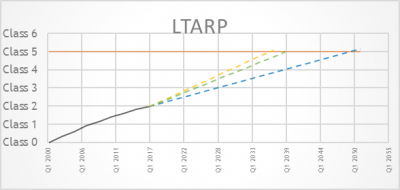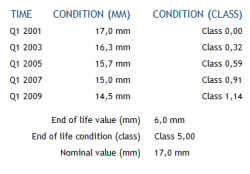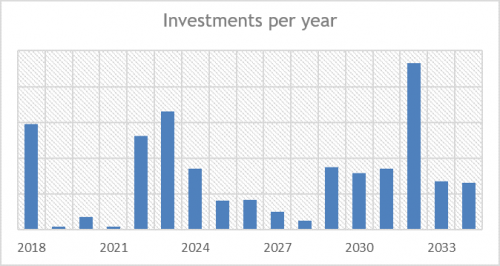The Long-Term Asset Replacement Plan – What is it and what is it used for?
Insufficient control over capex? Unexpected major expenses? The sentence: “that will definitely last another 10 years?” These are all good reasons to consider preparing a Long-Term Asset Replacement Plan (LTARP). I would like to use my contribution to this blog to explain what the LTARP is and what it is used for.
The ltarp in a nutshell
A Long-Term Asset Replacement Plan (LTARP) gives you an insight into the condition and degradation of your installations and, as such, the overall life and expected replacement period of assets. It also forms the basis for investment plans. If you link a replacement value to the life of an installation, it immediately becomes possible to visualize the investments necessary in the years ahead.
The LTARP results in a long-term investment plan, substantiated by a knowledge of systems, the market and employees.
Approach
After identifying critical assets, the following will be recorded for each asset individually:
- Current preventive maintenance. If preventive maintenance tasks replaces an item immediately and in full, the asset in question falls outside the scope of the LTARP;
- The level of replacement costs. If the replacement value is lower than the investment threshold, the asset in question will not be relevant for the LTARP;
- Failure Asset Mode (FAM).
It is important to indicate the failure mode for the assets that remain. If an asset fails on the basis of use and age, or if failure is the result of the fact that the asset is no longer available, because of which production would stop in the event of failure. The inability to replace an asset is a failure mode too, because control is lost in this situation. Obsolescence is an increasingly common phenomenon, which is quickly identified as part of the LTARP process and makes mitigating action possible.
The inability to replace an asset is not a problem in itself, provided you deliberately choose to run a certain risk. The preparation of a contingency plan (where appropriate) can obviate many concerns and consequential costs.
The next step is to establish the condition of the other installations and, depending on the failure mode, the expected replacement date. Depending on the detail required, this is possible at three levels: theoretical, analytical or academic.
Level 1 - Theoretical/Pragmatic
We draw on standards ISO15686 and the NEN2767 here. Initially, the condition of an installation will be determined on the basis of available data and discussions with the client. Checklists containing experiential information and questions that facilitate a substantiated determination of the condition of an asset will be used to arrive at the assessment below.
| Conditie score | Description | Explanation |
| 1 | Excellent condition | Incidental, minor defects |
| 2 | Good condition | Incidental, early-stage obsolescence |
| 3 | Reasonable condition |
Visible obsolescence in places Function performance by construction and installation parts not jeopardized |
| 4 | Moderate condition | Function performance by construction and installation parts jeopardized on an incidental basis |
| 5 | Poor condition | Obsolescence is irreversible; the installation must be replaced |
| 6 | Very poor condition | The installation is ready for disposal and can no longer be operated safely |
After establishing the condition, a degradation rate (end of life class/average life), an estimated intensity of use, an uncertainty factor and the commissioning date are used to determine an expected replacement date.
Level 2 - Analytical
The Analytical approach is more data driven. While the theoretical approach is based on the knowledge and experience of employees, Level 2 utilizes available data. An example of this could be, a pipe with a wall thickness measurement.


In the example above, Class 5 has been established as the 'end of life' for the client: this is the point at which the pipe needs to be replaced. The value (read: wall thickness) applicable at this time (6.0 mm in this case) can be used to arrive at a targeted estimate of when the pipe thickness will be less than 6 mm. It is also immediately clear which ‘class’ applies for the object at the time of measurement. The data generates information about the average life at the specific location and about intensity of use, which makes it easier to establish the degradation rate and intensity. The level of uncertainty ensuing from this analytical method is significantly less than would be the case if using the theoretical method.
Level 3 - Academic
The Academic method is the most extensive of the three methods, as part of which an asset-specific approach is offered - depending on the requirements of the individual client. This could include, for example, metallurgy, a non-destructive assessment or the involvement of engineering capacity. Although this method provides the most certainty, it is significantly more expensive as well.
If the time at which an installation will fail has been ascertained on the basis of one or more methods, replacement costs will be linked to the assets in the last step, after which the outcome as a whole will be visualized.

Best practice
The theoretical and analytical approaches are often combined in practice. Experience has taught us that this is often enough to provide clients with a well-substantiated starting point for budget requests.
Stork Asset Management Technology has produced LTARPs for various clients in a range of sectors. Clients like the insight that these plans give them and also the way in which issues are addressed. We draw on the knowledge that company employees have, objectify this knowledge and then supplement it with an assessment; all of this in consultation with the company itself. We also test and validate the choices we make with clients before continuing with the rest of the process. In this way, the client is not confronted with unwelcome surprises in the final assessment and is also provided with well-substantiated, supported advice to present to management for investment decision-making.